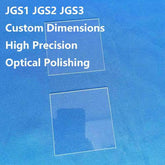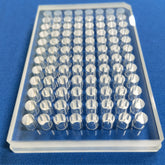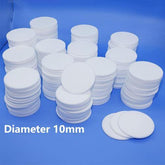Characteristics of Quartz Glass
Characteristics of Quartz Glass
This chapter introduces the significant characteristics and characteristics of quartz glass.
Chemical purity
Purity is one of the most important aspects in quartz glass manufacturing. Contaminants, even at very low levels, can affect the thermal, electrical, and optical properties of the quartz glass and materials in contact in the final application. Strict handling precautions must be taken at all stages of raw material sources and production to ensure high purity. The most common impurities are metal oxides (Al2O3, Fe2O3, MgO, etc.), water, and chlorine.
Water exists in the form of hydroxyl groups (OH) in quartz glass. The OH content can vary based on heat treatment and the moisture content of quartz glass exposed to high temperatures. OH affects infrared transmission, viscosity, and attenuation. High levels of OH can reduce infrared transmittance. OH can also reduce thermal stability; The high OH content means that quartz glass is not suitable for high-temperature terminal applications. The annealing step can reduce the OH content of quartz glass in the fused quartz glass.
Chemical behavior
Quartz glass is chemically inert to most compounds: water, salt, and acid, making it a favorable material for chemical laboratories and industry. It is basically not breathable. Hydrofluoric acid and phosphoric acid are the only reagents that can etch and decompose quartz glass at ambient temperature. However, alkali and alkaline earth reagents can corrode the surface, leading to accelerated devitrification. 0.1 milligrams of alkali per square centimeter can amplify the conversion of all semi stable molecules. Even fingerprints containing trace amounts of alkali can cause opacity.
Thermal performance
Quartz glass is famous for its extremely low coefficient of thermal expansion (CTE). Thermal expansion refers to the small changes in the size of an object that occur with temperature. For most materials, CTE is proportional to temperature changes. Quartz glass also has excellent thermal shock resistance and can withstand sudden and extreme temperature changes. Quartz glass also has low thermal conductivity.
Quartz glass begins to soften from 1630 ° C and at high temperatures, it acts like most types of viscous liquids in glass. This state occurs over a wide temperature range, and viscosity decreases with increasing temperature. The presence of impurities also increases viscosity.
Mechanical properties
Compared with other glass types, quartz glass has almost similar mechanical properties. Quartz glass has high compressive strength, but also exhibits high brittleness. Surface defects can also affect the overall strength of this material. Machine polished parts are often weaker than fire polished parts. In addition, due to exposure to the environment, the lifespan of glass can also affect its reliability.
optical characteristics
Quartz glass has become a research topic due to its extensive optical transmission characteristics, covering the ultraviolet region, visible light, and infrared wavelengths. It can be further enhanced by adding doped materials. The transmittance is influenced by the purity and OH content of quartz glass. The increase of metal impurities and OH molecular vibrations and rotational excitation will lead to light absorption, thus affecting the subsequent transmission.
Electrical performance
Quartz glass is an excellent electrical insulator that maintains high electrical resistivity at high temperatures. It has high dielectric strength. This is due to the absence of charged mobile ions and strong silicon oxygen bonds in the molecular lattice, resulting in a very low polarizability of the structure.
The following table summarizes some important performance coefficients of quartz glass discussed in this article:
|
Property |
value |
|
Density |
2.2 x 10-3 kg/m3 |
|
Hardness |
5.5 – 6.5 Mohs scale |
|
Design tensile strength |
7,000 pounds /square inch |
|
Design compressive strength |
160,000 pounds /square inch |
|
Stiffness modulus |
4.5x106 pounds /square inch |
|
Coefficient of thermal expansion |
0.55 x 10-6/°C |
|
Thermal conductivity (20 ° C) |
1.4 W/m-°C |
|
Specific heat (20 ° C) |
670 J/kg-°C |
|
Softening point |
1683°C |
|
Annealing point |
1215°C |
|
Strain point |
1120°C |
|
Resistivity (350 ° C) |
7x10-7/° ohm-cm |
|
Dielectric characteristics (20 ° C, 1 MHz) ·Constant ·Strength |
3.75 |
|
Refractive index |
1.4585 |
|
Shrinkage (Nu value) |
67.56 |
|
The velocity of acoustic shear waves |
3.75 x 10-3/° m/s |
|
Sound velocity/compressed wave |
5.90 x 10-3° m/s |
|
acoustic attenuation |
<11dB/m MHz |






